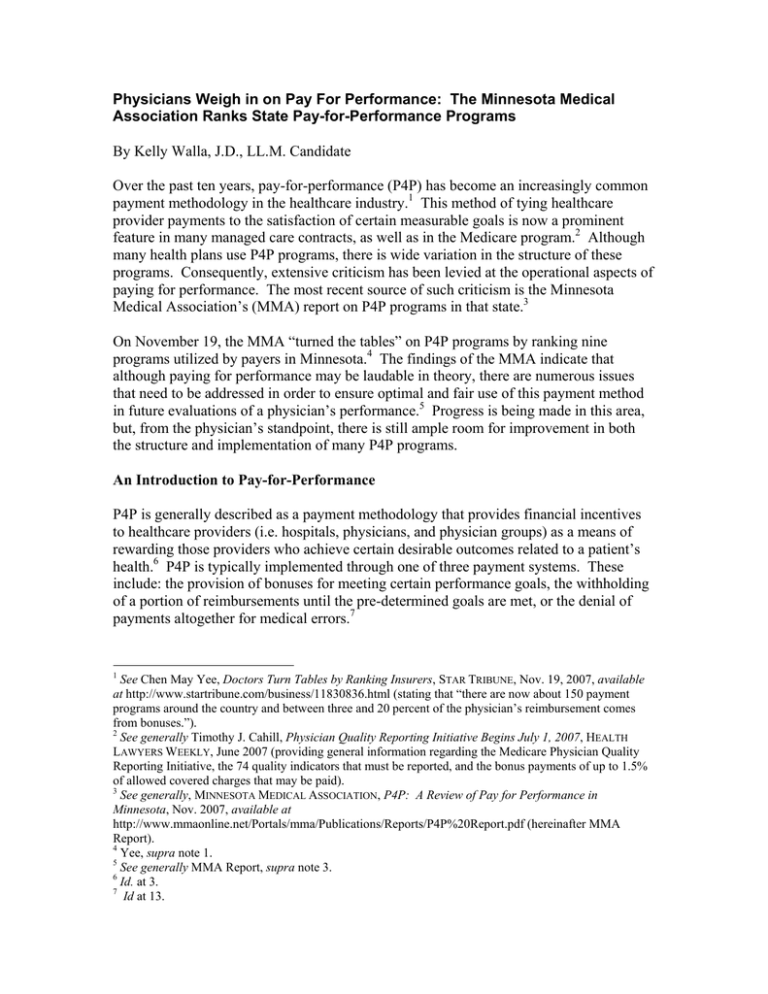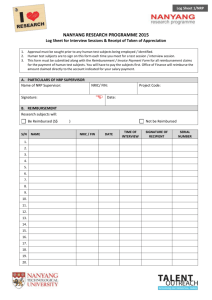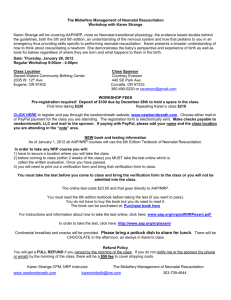Physicians Weigh in on Pay For Performance: The Minnesota... Association Ranks State Pay-for-Performance Programs
advertisement

Physicians Weigh in on Pay For Performance: The Minnesota Medical Association Ranks State Pay-for-Performance Programs By Kelly Walla, J.D., LL.M. Candidate Over the past ten years, pay-for-performance (P4P) has become an increasingly common payment methodology in the healthcare industry.1 This method of tying healthcare provider payments to the satisfaction of certain measurable goals is now a prominent feature in many managed care contracts, as well as in the Medicare program.2 Although many health plans use P4P programs, there is wide variation in the structure of these programs. Consequently, extensive criticism has been levied at the operational aspects of paying for performance. The most recent source of such criticism is the Minnesota Medical Association’s (MMA) report on P4P programs in that state.3 On November 19, the MMA “turned the tables” on P4P programs by ranking nine programs utilized by payers in Minnesota.4 The findings of the MMA indicate that although paying for performance may be laudable in theory, there are numerous issues that need to be addressed in order to ensure optimal and fair use of this payment method in future evaluations of a physician’s performance.5 Progress is being made in this area, but, from the physician’s standpoint, there is still ample room for improvement in both the structure and implementation of many P4P programs. An Introduction to Pay-for-Performance P4P is generally described as a payment methodology that provides financial incentives to healthcare providers (i.e. hospitals, physicians, and physician groups) as a means of rewarding those providers who achieve certain desirable outcomes related to a patient’s health.6 P4P is typically implemented through one of three payment systems. These include: the provision of bonuses for meeting certain performance goals, the withholding of a portion of reimbursements until the pre-determined goals are met, or the denial of payments altogether for medical errors.7 1 See Chen May Yee, Doctors Turn Tables by Ranking Insurers, STAR TRIBUNE, Nov. 19, 2007, available at http://www.startribune.com/business/11830836.html (stating that “there are now about 150 payment programs around the country and between three and 20 percent of the physician’s reimbursement comes from bonuses.”). 2 See generally Timothy J. Cahill, Physician Quality Reporting Initiative Begins July 1, 2007, HEALTH LAWYERS WEEKLY, June 2007 (providing general information regarding the Medicare Physician Quality Reporting Initiative, the 74 quality indicators that must be reported, and the bonus payments of up to 1.5% of allowed covered charges that may be paid). 3 See generally, MINNESOTA MEDICAL ASSOCIATION, P4P: A Review of Pay for Performance in Minnesota, Nov. 2007, available at http://www.mmaonline.net/Portals/mma/Publications/Reports/P4P%20Report.pdf (hereinafter MMA Report). 4 Yee, supra note 1. 5 See generally MMA Report, supra note 3. 6 Id. at 3. 7 Id at 13. Regardless of the precise mechanism used to pay-for-performance (i.e. bonus payments, withholding payments, or denying payments altogether), it is clear that outcome measures are generally the focal point of P4P programs. This outcome-based approach represents a fundamental shift in the payment of healthcare services.8 Under the traditional healthcare-delivery paradigm, providers have largely been compensated “for treating patients when they are sick, not to keep them well.”9 Under P4P programs, providers are rewarded for reaching targets related to efficiency and quality in patient care, rather than solely for the number of services provided to a patient (i.e. quality over quantity).10 This method of incentivizing providers is, in theory, supposed to make the provider more conscious of clinical processes and objective performance standards, thereby improving the quality and efficiency of healthcare services delivered to the patient. Proponents of P4P note that most professions outside the healthcare industry link compensation to performance.11 Thus, they view P4P in health plans as a logical extension of this payment method to the medical profession. In fact, some view P4P as the health insurance industry’s natural reaction to burgeoning healthcare costs. Under P4P, payers seek to ensure that their rates are commensurate with the level of quality delivered by each provider, as well as to drive quality improvements.12 This accounts for P4P’s alternate moniker of “value-based purchasing.”13 It is difficult to argue with the stated goals of P4P; however, the ability of P4P to actually achieve a positive effect on the quality of healthcare remains unclear.14 A study discussed in a 2005 article in the Journal of the American Medical Association concluded that only modest gains in quality were made as a result of the P4P program used in certain PacificCare networks in California (when compared to non-P4P programs in PacificCare’s Pacific Northwest network).15 Specifically, the study examined the effect of P4P on mammography, cervical cancer screenings, and hemoglobin testing for diabetic patients.16 Upon analyzing the collected data, the study concluded that “compared with physician groups in the Pacific Northwest, the California network demonstrated greater quality improvement after the pay-for-performance intervention only in cervical cancer screening (a 3.6% difference in improvement).”17 Thus, despite its increasing popularity in the healthcare industry, P4P is far from a tried-and-true means of improving healthcare 8 MMA Report, supra note 3 at 3. Yee, supra note 1. 10 MMA Report, supra note 3 at 3. 11 See, e.g, Karen Corrigan and Robert H. Ryan, New reimbursement models reward clinical excellence: pay-for-performance means that quality and revenue are no longer separate issues for healthcare providers, HEALTHCARE FINANCIAL MANAGEMENT, Nov. 2004, available at http://findarticles.com/p/articles/mi_m3257/is_11_58/ai_n6362156. 12 See, e.g., John W. Rowe, Pay-for-Performance and Accountability: Related Themes in Improving Health Care, ANNALS OF INTERNAL MEDICINE, 695-699 (2006), available at http://www.annals.org/cgi/content/full/145/9/695?ex. 13 Id. 14 MMA Report, supra note 3 at 12. 15 Meredith B. Rosenthal et al., Early Experience with Pay-For-Performance, JAMA, 1788-1793 (2005), available at http://jama.ama-assn.org/cgi/content/abstract/294/14/1788. 16 Id. 17 Id. 9 quality. Additional studies will be necessary to demonstrate the effectiveness of P4P. And until further data is available, many will consider P4P to be in the “experimental” stages of development.18 Given the current dearth of data statistically proving P4P’s effectiveness, health plans should be especially mindful of the potential negative consequences of paying for performance when structuring their programs. Individuals subject to P4P programs (namely, healthcare providers) may be one of the most useful sources of information on this subject. Yet, the physician’s perspective has been underutilized in many programs. Health plans would be well-advised to consider incorporating the physician’s perspective on P4P into their plans in order to structure optimal programs, as well as to gain provider acceptance of and participation in their programs. Among the concerns voiced by physicians, physician organizations, and other commentators regarding P4P programs in general over the last few years are the following: (1) Concerns regarding the clinical validity of performance measures used in P4P programs. Many physician organizations have emphasized the importance of P4P standards being supported by evidence-based medicine and developed collaboratively with the input of physicians.19 To do otherwise would potentially impinge on the practice of medicine and unfairly penalize providers who provide high-quality services, yet fail to conform to P4P program guidelines that do not recognize the range of proper clinical standards. If P4P is truly designed to improve quality, proper clinical guidelines are imperative. (2) Concerns regarding the administrative burdens associated with documenting performance-measure compliance. Given the lack of uniformity in criteria utilized for P4P programs, physicians may spend an inordinate amount of time and resources documenting compliance with various P4P programs. Both collection and reporting of necessary data may be labor intensive and detract from the time that the physician’s staff could be spending on other tasks. Many physician organizations have proposed that P4P programs take measures to ease the administrative burdens associated with program compliance. For example, the American Medical Association’s (AMA) 2005 “Guidelines for Pay-for-Performance Programs” states that programs should reimburse physicians for “any added administrative costs incurred as a result of collecting and reporting data to the program.”20 (3) Concerns regarding the health information technology costs incurred by providers in P4P programs. In order to effectively gather performance data, some P4P programs may be heavily reliant on health information technology, such as electronic 18 See, e.g., Yee, supra note 1. See, e.g., THE AMERICAN MEDICAL ASSOCIATION, AMA: Guidelines for Pay-for-Performance Programs, June 21, 2005, available at http://www.amaassn.org/ama1/pub/upload/mm/368/guidelines4pay62705.pdf 20 Id at 3. 19 medical records (EMRs). For many providers, this is problematic because they have not yet converted to an EMR system due to the expensive nature of this transition. Thus, numerous physician organizations have suggested that P4P take these technological constraints into consideration when structuring their plans and “offer financial support to physician practices that implement IT systems or software that interact with aspects of the PFP program.”21 (4) Concerns regarding the potential for access-to-care problems if P4P programs fail to make risk adjustments based on a provider’s patient population. Many commentators have noted the importance of P4P programs making risk adjustments for a physician’s patient population. Since a physician who treats seriously-ill patients may receive lower outcome results based solely on his patient base (and not his quality-ofcare), it is important for P4P programs to make risk adjustments based on each provider’s patient population. To do otherwise might discourage physicians from treating patients who present with the most severe cases. To this end, the AMA’s “Guidelines for Payfor-Performance Programs” state that “performance measures must be subject to the bestavailable risk adjustment for patient demographics, severity of illness, and comorbidities.”22 Pay for Performance: The Minnesota Medical Society’s Articulation of the Physician’s Perspective In many respects, the MMA’s recently-released “Review of Pay for Performance in Minnesota” reiterates the prior concerns of physicians and serves to highlight continued issues with P4P programs.23 In particular, the MMA evaluated nine P4P programs in its state in order to assess each program’s degree of alignment with the MMA’s “Principles for Pay for Performance.”24 Principles of primary concern to the MMA include evaluating whether the plans “drive improvements to health care quality; promote and strengthen the partnership between physicians and patients; support and facilitate broad participation; and incorporate credible, reliable, transparent, and valid measures of performance.”25 The MMA report indicates that most of Minnesota’s programs are, in fact, consistent with multiple, critical MMA principles, such as the principles encouraging program standards to be “evidence-based, useful, and support[ive of] the physician-patient relationship.”26 However, some programs appear to be lacking in other areas, such as the facilitation of health information technology (HIT) and in minimizing administrative burdens.27 21 Id at 4. Id at 1. 23 See generally, MMA Report, supra note 3. 24 Id. 25 Id. at 2. 26 Id. 27 Id. 22 The nine programs ranked by MMA include: CMS’ Physician Quality Reporting Initiative; Bridges to Excellence; HealthPartners: Partners in Progress; HealthPartners: Partners in Excellence; Blue Cross Blue Shield Minnesota Recognizing Excellence Program; Medica: Performance-Based Incentive; Medica: Choice Care Quality Improvement Program; UCare P4P program; and PreferredOne.28 In ranking the nine P4P programs’ alignment with MMA’s principles, CMS’ Physician Quality Reporting Initiative received the highest score, followed by Blue Cross Blue Shield’s Minnesota Recognizing Excellence Program.29 The lowest score was received by the Bridges to Excellence program.30 The MMA report stated that those programs with lower degrees of alignments with MMA principles may attribute their score reductions to certain practices, such as failing to adjust incentives based on the patient population, increasing administrative burdens, and mandating physician participation.31 While cautioning that administrative burdens are one major issue remaining with P4P programs in general, the MMA report praised those programs which have instituted measures to ease administrative burdens and to aid data collection, including Bridges to Excellence, Ucare, CMS, and PreferredOne programs.32 From reviewing the MMA report, it is clear that P4P programs are addressing some physician concerns, yet have ample room for improvement in the future. A continued dialogue between payers and physicians may aid in the functionality and palatability of the programs to both patients and physicians. To this end, the MMA report offered four general suggestions for improving alignment with the MMA P4P principles in the future. In particular, the MMA report stated that the programs should: 1) recognize and reward physicians for systems improvements, including HIT adoption, care coordination, and use of evidencebased medicine; 2) decrease the administrative burden and work toward a coordinated and cohesive measurement effort, specifically concerning measurement sets, specifications, and data collection methodologies; 3) use risk-adjustment methodologies that account for variations in patient populations; and 4) not place physicians in situations that create ethical conflicts that could jeopardize patient safety or limit shared patient decisionmaking.33 28 Id. at 22. Id.; see also Yee, supra note 1. 30 Id. 31 Id. at 2. 32 Id. at 23. 33 Id. at 2. 29 Conclusion In conclusion, effort must continue to be made to bridge the gap between the physician’s perspective on P4P (as illustrated by the MMA principles for pay for performance) and the methods actually used by various third-party payers. Congress and CMS have been responsive to physician concerns by selecting the American Medical Association’s (AMA) Physician Consortium for Performance Improvement as the body to develop measures for the CMS Physician Quality Reporting Initiative (PQRI) program.34 This may account for the PQRI receiving the highest rating by the MMA. More widespread incorporation of physician perspectives may add to a sense of fairness in other P4P programs and minimize the burden associated with such programs. In turn, P4P programs will more likely comport with their stated purpose and truly improve the quality of care that patients receive. 34 Id. at 5.





